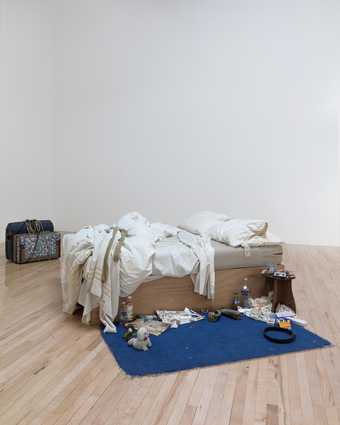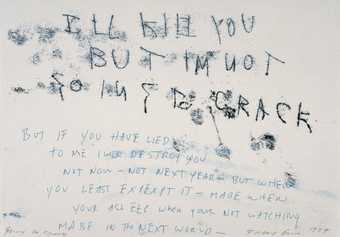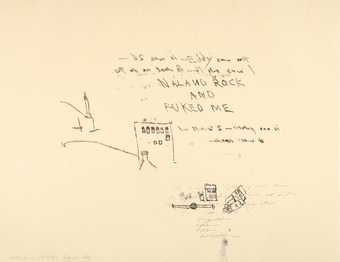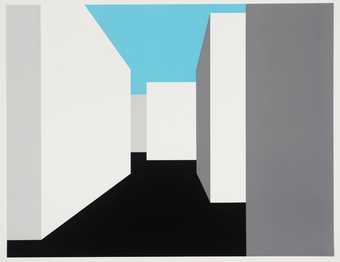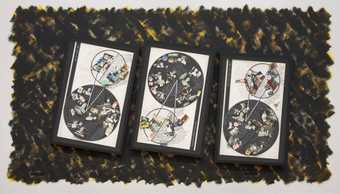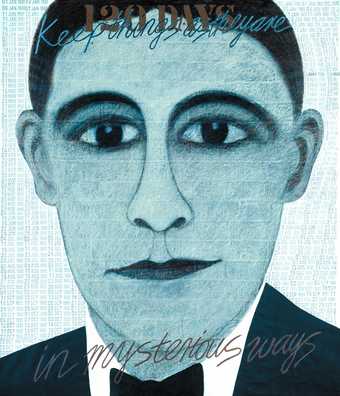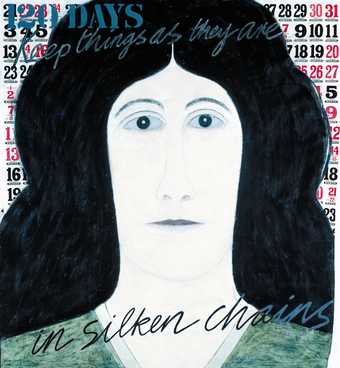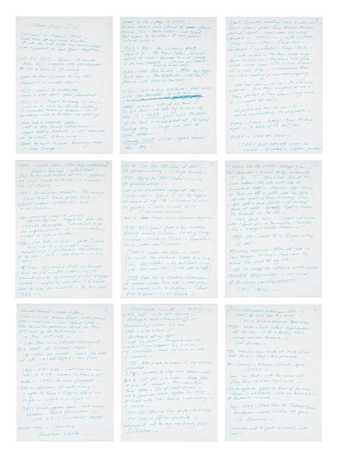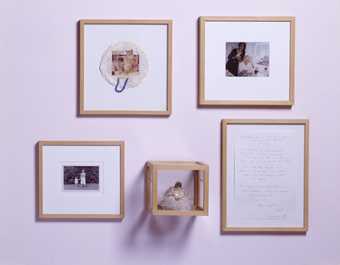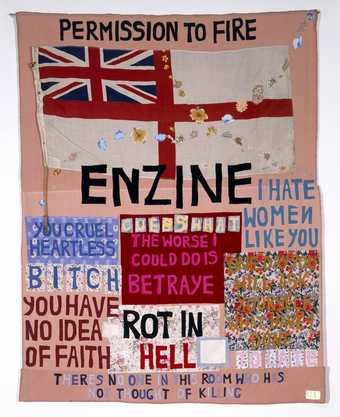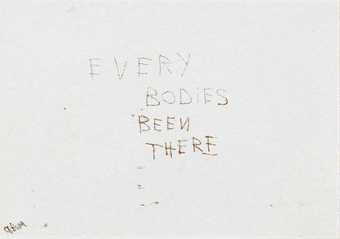Not on display
- Artist
- Tracey Emin born 1963
- Medium
- Plaster
- Dimensions
- Overall display dimensions variable
- Collection
- Tate
- Acquisition
- Presented by the artist 2004
- Reference
- T11892
Summary
This work comprises eleven plaster seagulls hanging in the gallery space as though they are swooping towards the viewer. The seagulls are cast from the same mould and bear the words ‘I COULD REALLY HAVE LOVED YOU’ in raised textured capitals across their backs and wings. These words were originally part of the work’s title. The seagulls are suspended from the ceiling using fishing wire in flock formation: one in front, followed by two, then three, then five. The plaster casts, painted with a coat of white acrylic, have a fragile, bone-like quality.
Much of Emin’s work is based on her family and heritage. The love child of two people separately married to others, she and her twin brother Paul had an unusual family history, which is partly narrated in her text work, Exploration of the Soul 1994 (Tate T11887). After spending their earliest years in Cyprus, the two children were brought to the suffocating idyll of the Hotel International in Margate, which was owned by their property developing Turkish-Cypriot father. When he became bankrupt the hotel was closed down and their parents separated. The twins suffered a downgrading of their comfortable lifestyle as their English mother struggled to support them alone. After series of disappointments, the brutal reality of the world was forced upon Emin by rape at the age of thirteen. The seaside town of Margate provided the backdrop for the artist’s distressed youth, where the torture of small-town communities was relieved by the natural beauty of the sea.
Many works celebrate the artist’s relationship with particular family members. May Dodge, My Nan (Tate T11886), Me and Paul
1963-93 (private collection) and Dad 1993 (Tate X08679) are collections of memorabilia including photographs from the family albums and text narrated by the artist. Emin’s father has appeared in person in video footage in Emin & Emin. Cyprus 1996 1996 and The Perfect Place to Grow
2001 (see Tate T11791). One of Emin’s most famous works (now destroyed), Everyone I have Ever Slept With 1963-1995, 1995, features just about every member of her family as she had at some point or another shared a bed with them all. Many of these works are, more or less directly, concerned with mortality. Uncle Colin 1963-93 (private collection) records the dramatic death of the artist’s uncle. She has commented:
My family has always been psychic, especially Uncle Colin who died. He was decapitated in a car crash. It only took a moment. He was holding a Benson and Hedges packed just before he died. It looked like real gold. In my family when we die we are cremated and our ashes are thrown into the sea amongst the seagulls. I love seagulls. I’d like to be one.
(Quoted in Morgan, p.58.)
Birds appear repeatedly in Emin’s work. Many of her monoprints feature scratchy drawings of birds; usually these are small domestic birds such as sparrows and owls with anthropomorphic qualities. Seagulls are unromantic and unpoetic birds; they reflect the landscape of seaside towns where they are a constant presence scavenging for scraps of food. Birds have traditional symbolic value as the soul or even poetic imagination; in Emin’s work they represent a stark, but beautiful, take on reality. An emblem of the family, flying together, Emin’s seagulls may also represent the flight of her adolescent self from the restrictions of a small town provincial life to the big city where she has made her name and fortune.
Further reading:
The Turner Prize 1999, exhibition brochure, Tate Gallery, London 1999, [pp.4-5]
Neal Brown, Matthew Collings and Sarah Kent, Tracey Emin, exhibition catalogue, South London Gallery 1997, pp.37 and 58, reproduced pp.2-3 and p.33 in colour
Stuart Morgan, ‘The Story of I’, Frieze, issue 36, May 1997, pp.57-61
Elizabeth Manchester
November 2004
Does this text contain inaccurate information or language that you feel we should improve or change? We would like to hear from you.
Technique and condition
The following entry is based on an interview with Tracey Emin at Tate Britain on 26 August 2005, as well as the conservation record held in Sculpture Conservation.
An installation comprising eleven solid plaster seagulls all cast from the same mould.
Across the back of each seagull are cut out felt letters which spell ‘I COULD HAVE REALLY LOVED YOU’. There are hand tool markings on each seagull where the plaster surface was individually finished by the artist. The seagulls were then brush painted with white paint.
There are holes drilled through the wing tips and tail of each seagull for installation purposes. The birds are hung from the ceiling through individual lengths of Perspex wire knotted to further lines of wire fixed across the ceiling under tension. The birds are positioned so that they are gently angled towards the gallery floor. This means that the lettering is barely visible from the ground. Emin noted in the interview of August 2004 that she wants the Tate Britain 2004/5 display layout to be used as a guide allowing for subtle variations when adapting to different gallery spaces.
The seagulls are in good condition with minor signs of wear and tear. Any changes, such as yellowing of the paint and subsequent minor damage caused by natural ageing, are acceptable to the artist.
Jodie Glen-Martin and Bryony Bery
August 2005
Explore
- abstraction(8,615)
-
- non-representational(6,161)
-
- text(1,043)
- emotions and human qualities(5,345)
-
- escapism(11)
- birth to death(1,472)
- family(1,081)
You might like
-
Tracey Emin My Bed
1998 -
Tracey Emin Going to Crack
1997 -
Tracey Emin Fuck You Eddy
1995 -
Julian Opie Imagine you are walking
1998–9 -
Julian Opie Imagine you are driving
1998–9 -
Stephen Willats Are you Good Enough for the Cha Cha Cha?
1982 -
Ian Breakwell Keep Things as They Are: In Mysterious Ways
1981 -
Ian Breakwell Keep Things as They Are: In Silken Chains
1981 -
Julian Opie There are hills in the distance (c)
1996 -
Julian Opie You are driving a Volvo
1996 -
Tracey Emin Tracey Emin C.V.
1995 -
Tracey Emin May Dodge, My Nan
1963–93 -
Tracey Emin Exploration of the Soul
1994 -
Tracey Emin Hate and Power Can be a Terrible Thing
2004 -
Tracey Emin Everybodies been there
1997


